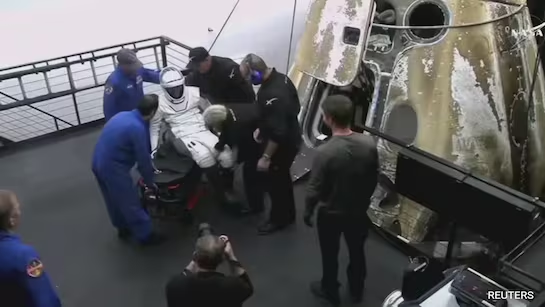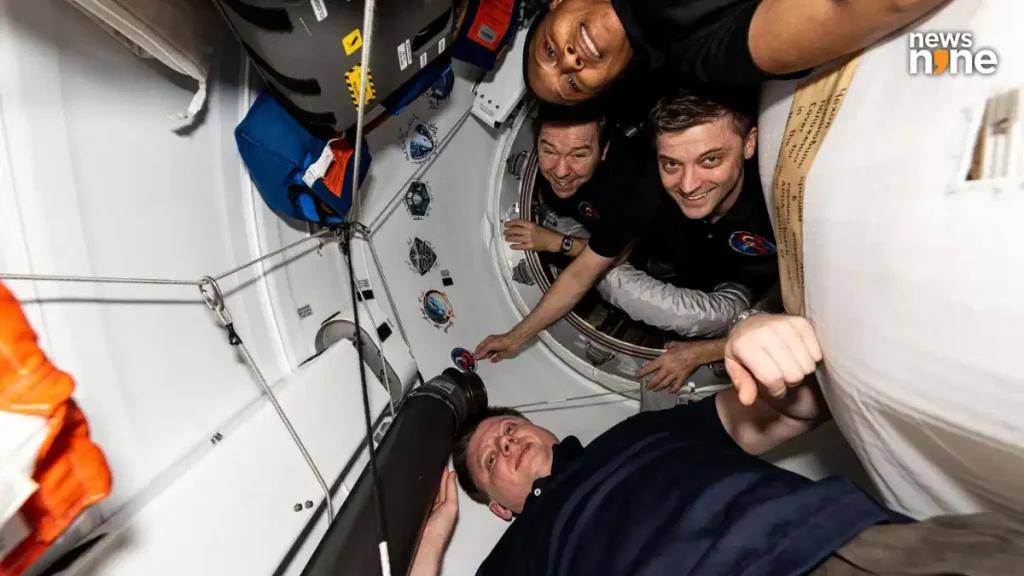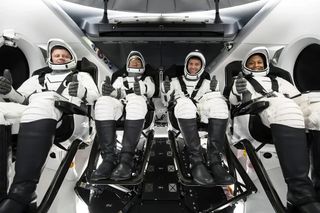Four crew members who had recently returned from the International Space Station (ISS) were transferred to a medical facility in Florida on Friday morning following an early-morning splashdown in the Gulf of Mexico. The four-person crew, consisting of three NASA astronauts, Matthew Dominick, Michael Barratt, Jeanette Epps, and Russian cosmonaut Alexander Grebenkin, were part of the SpaceX Crew Dragon mission, Crew-8, which marked one of the longest-duration ISS stays for U.S. astronauts, clocking in at 235 days.
After a successful and safe splashdown, which took place at 3:29 a.m. ET, NASA stated that the crew was taken to Ascension Sacred Heart Pensacola, a nearby medical facility, for additional evaluation. According to NASA spokesperson Cheryl Warner, this step was part of standard post-mission protocol, as astronauts undergo extensive health checks following long-duration space missions. However, one of the astronauts remained at the Florida hospital as of Friday afternoon due to an unspecified medical issue, though Warner confirmed that the individual was in stable condition and under observation.

NASA refrained from disclosing details about the condition or identity of the astronaut to respect medical privacy. Following the check-up, the three other crew members were cleared to fly back to NASA’s Johnson Space Center in Houston, where the full crew was originally based. The 235-day mission set a record for the longest time a U.S.-crewed spacecraft has been in orbit, as explained by Richard Jones, deputy manager of NASA’s Commercial Crew Program.
Crew-8’s return was delayed by several factors, including weather and scheduling changes. A notable delay came from issues with the Boeing Starliner spacecraft, which completed an uncrewed test flight earlier in the year but was deemed unfit to return astronauts to Earth. Consequently, two astronauts originally scheduled for the Starliner were reassigned to the upcoming Crew-9 mission on SpaceX’s vehicle, further pushing back Crew-8’s return timeline.
Space missions often require astronauts to undergo thorough medical evaluations post-flight, as prolonged periods in space can have significant effects on the human body. Reduced bone density, muscle atrophy, and fluid distribution changes are common challenges due to microgravity. The NASA medical team routinely monitors astronauts for these conditions to understand better and mitigate the health risks associated with extended space stays.

The Crew Dragon capsule performed smoothly upon re-entry and splashdown, with all crew members appearing in good spirits as they exited the capsule and waved to the cameras aboard the recovery ship. Jones expressed optimism in a news briefing held at 5 a.m. ET, stating, “Right now, the crew is doing great. They’ll soon be on their way back to Houston after all of those [medical checks] are done.”
SpaceX’s Crew Dragon spacecraft, developed in collaboration with NASA under the Commercial Crew Program, has played a pivotal role in enabling the U.S. to maintain regular missions to the ISS. The Crew-8 mission adds to the success of this program, which has advanced U.S. space capabilities and has created a stable routine for astronauts traveling to and from the ISS. As SpaceX continues its ISS missions, NASA’s partnership with private space firms demonstrates a shift toward commercially sustained low Earth orbit ventures.

The Crew-8 mission underscored the importance of international collaboration in space, as it included the Russian cosmonaut Grebenkin amid geopolitical tensions between the U.S. and Russia. NASA and Roscosmos, the Russian space agency, continue to coordinate ISS missions, focusing on maintaining a cooperative relationship in space despite political tensions on the ground.




